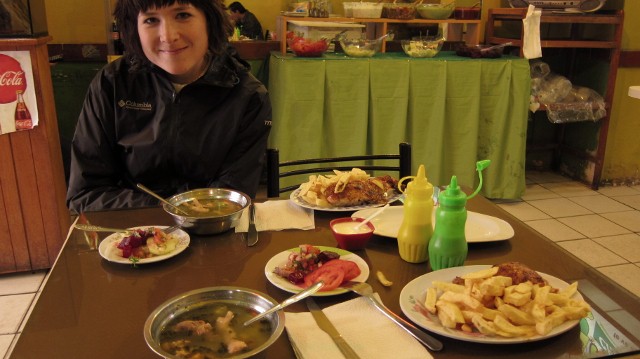"...oh for a life of sensations rather than of thoughts!" - John Keats
Food is a core component of life. It gives us energy, it gathers us around a table and makes us social. We didn't consciously plan to take photos of all the food we ate or encountered so far, so this post was more of an after-thought, using the photos we had that matched the food theme.
Food in Peru can be either very tasty or very flavorless, depending on where you eat it. Lima is known for its amazing restaurants, ceviche and pisco sours, but we sadly didn't have the time, nor budget, to explore any of that. As far as the rest of the country, they eat a lot of deep fried stuff, rice, potatoes, bread and corn dishes. This place is starch and carb central. We are now craving veggie salads, and veggies in general. Eating bread and potatoes (boiled, fried, mashed, etc.) can get really old after a while. The upside of eating so many carbs is that it helped us with energy during the Inca trail hike and it prevented us from getting sick.
The photos below are a small selection of some of the things we ate while in Peru. Enjoy!
 |
| Our first meal ever in Peru was in a mall close to our hostel. I got Arroz con Pollo and Anne got Lomo Saltado, two of the most common dishes of Peru. |
 |
| Escabeche de pollo (chicken stew cooked with onion and tomato sauce) |
 |
| Chuleta a la pobre = poor man's meal, includes fried pork meat, rice, french fries, fried plantain and one fried egg. All this for 15 soles (5 USD) |
 |
| Lunch in Barranco (a cute neighborhood in Lima) : tiradito de aji (raw fish marinated in a garlic and lemon juice), chupe de camarones on the right (soup with little pieces of fish) |
 |
| Dinner served on the 22-hour bus ride from Lima to Cusco. |
 |
| The cui (guinea pig) cook. |
 |
| Roasted guinea pigs. As you can see, they cook these little guys whole, with claws, teeth, eyes, internal organs, everything still on. I have to say I found this a little gross. |
 | ||||||||||||||||||
| The floating islands of the Uros are made of totora reeds. Totora is a plant that grows on lake Titicaca and is used to build houses, fishing boats and pretty much everything. The soft white bottom part of the plant is edible and has a spongy taste. Totora can also be found on Easter Island. You can read more about it here. |
 |
| Anne eating a piece of chicken feet found in the soup included in her fixed price menu. The soup had all sorts of chicken parts, such as gall bladder, neck, feet, cartilages, none of which had any meat on them, but gave the soup a great chicken-y flavor. |
 |
| In Puno we splurged and got alpaca steaks at a nicer restaurant. Alpaca meat is very lean and supposedly contains only 50% of the fat found in beef meat. It was very delicious and tasted a little bit like lamb chops. |
 |
| Mixed fruit juices were a staple on the menus of many restaurants. They usually mix apple, banana, papaya or passion fruit (maracuya) juices, blended either with water or milk. |
 |
| Expanded corn, in the mercado in Puno. I tried to find out how this is made, but couldn't quite understand the entire explanation in Spanish. You basically throw huge corn kernels in a huge iron container over fire. You also add some sugar. Sounds a lot like popcorn, but without the oil. The size and sweetness level of the expanded corn determines the price. It's usually around 4 Soles for 1/2 a kilo. |
 |
| Fruit stand in the mercado in Puno. |
 |
| This type of woman is called Chola or Cholita. It means a peasant Quechua woman dressed traditionally (bowler hat, shawl and giant pleated skirt) who moved to the city. The term was used derogatory initially, but now it's used just to refer to women who dress like that. Most of the grains (flour, pasta, sugar, rice, wheat, etc.) in the mercado are kept in big sacks and you buy by the kilogram. |
 |
| We slept one night in the house of a family on Amantani island. For 30 Soles, the family provides you with a bed for a night and 3 meals. This was one of the meals they offered us: boiled potatoes and a big chunk of fried cheese. They can't grow fruit or vegetables on this island due to the high altitude, cold weather and dry soil, so all veggies and fruit has to be shipped in from the mainland and are more expensive. That's why people here eat potatoes and cheese for almost every meal. |
 |
| This is muña tea, a medicinal plant restricted to the South American Andes from Venezuela to Bolivia. It grows in a big bush all over the mountains here and on the side of the roads and it smells a lot like mint. Add a tiny branch to a cup of boiled water and you have a great flavorful cup of tea. |





